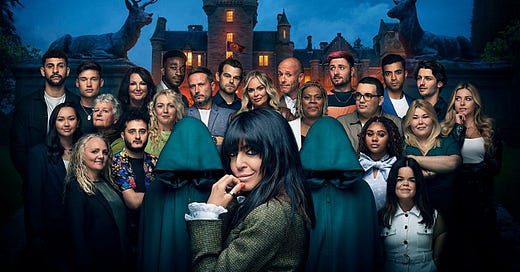Why is The Traitors so compelling?
A rare bit of TV analysis. Plus! A map of Europe’s megalopolis-es.
The new series of The Traitors has just started on BBC One, and once again I am obsessed. I'm not normally a reality TV fan - if I'm gonna watch someone having a breakdown on TV I much prefer them to be fictional, or a Cabinet minister - so towards the end of season one in December 2022 I tried to work out exactly why this one had got me.
One by one, 17 people sat around a round table in a darkened room are revealing which of their number they believe to be a traitor. We are halfway through, and the same two names are coming up over and over again. One is a self-consciously clever Cambridge physicist, who is smirking, and seems, if anything, amused that everyone has turned on him. The other is crying. Neither man is actually a traitor.
“I’m sorry, can I take a second,” the crying estate agent says and rushes from the room, to a place where unidentified members of the production team tell him to breathe. “I fucked up,” a man with a beard – the man whose accusation pushed the estate agent over the edge – whispers to himself. “I feel sick.” He appears sincere. Almost no one in the room knows that he actually is a traitor. It is entirely unclear whether he, too, has forgotten it is just a game – or whether he is just playing it really, really well.
The Traitors, the BBC’s surprise winter hit is, like so much else these days, a remake of a show already broadcast abroad, and is – let’s be clear on this – extraordinarily silly. Its format – 22 people in a Scottish castle have to identify which of their number are “murdering” the others by sending them a letter in the early hours – sits at the exact midpoint between the popular parlour game of wink murder and the Milgram Experiment. As if that weren’t silly enough, in the middle of each episode, the contestants are forced to engage in genuinely ridiculous It’s A Knockout-style “tasks” – pushing barrels to the top of a hill literally miles away; building fuses for two giant Wicker Man-esque bunny rabbits – that feel entirely at odds with the backstabbing and psychodrama that’s the meat of the show. (Sample quote: “You gotta go faster! Weigh the worms!”)
The silliness comes, too, from the near toxic levels of campness with which all this is done. Each night, the traitors are forced to don hoods and ascend a tower, where they plot: this is presumably exhausting but then, worried about being murdered, nobody else is getting any sleep either. When someone leaves the show, either murdered by their traitors or banished by their peers, the weird, AI-style portrait of their face that hangs in the breakfast room is taken down and crossed through with a thick red-line. Then there’s the soundtrack, all sinister, minor key covers and screeching strings, that bring back memories of the heightened heartbreak or loneliness or betrayal you have to be a teenager to feel. Claudia Winkleman oversees all this from within a range of knitwear so capacious she might get lost in it. The whole thing is ludicrous.
And yet, it’s one of the most compelling TV shows I’ve seen in years. Despite being not just reality TV, but ostensibly the bad sort of reality TV – the sort that’s deliberately manipulative, and needs counsellors in attendance in case the production accidentally gives someone a breakdown – it’s been occupying a corner of my brain ever since I caved first and caught up, just to shut up the friend who kept badgering me to watch it.1
This, of course, is why I’m writing about it, in the hope of getting it out.
Since all this was in my brain anyway, I’ve been trying to work out why it’s so compelling. Some of it is clearly the same thing that makes any show watchable – casting and editing and an eye for the great TV moment. (I’m doing my best to write this without spoilers, but my own personal highlight, for those who’ve been watching, was the incredible Maddy’s helpful, “I thought you were gonna get with her?”) But there are, I think, two other reasons.
One is that, despite what I said above, it isn’t actually that nasty a show: it may look like one, but, like the silly hoods and OTT music, it’s all performative. In fact, to an extent that can’t be just a coincidence, the contestants are largely incredibly likeable, even the ones who at first seem absolutely hateful, and the tasks are designed to build camaraderie as much as distrust. (Another example, that’ll only make sense to those who’ve already watched it: the normally abrasive Hannah gently telling Rayan that no one will judge him if he can’t cope with being buried alive for a task.) This is not a castle full of Apprentice contestants or Nasty Nick figures, intent on trampling each other in pursuit of victory, but of perfectly decent people who, having shared this deeply weird experience, obviously feel increasingly close to one another.
Which is what makes it so fascinating when the game requires them to destroy each other anyway.
The other thing that makes all this so compelling is the insights it offers into crowd behaviour. There’s no moral content to being a traitor – all it means is someone has been picked by the production team, and has lied competently enough to have not yet been found out.
Yet over and over again we see people convinced they have identified one of the others as off, in some way. Unnervingly often, this certainty that they can read people, plus a dash of charisma, is enough to bring the room with them, until one after another the people at that table change their minds and vote for the person they were convinced, just moments ago, was innocent.
It’d be terrifying, if this was real life. At least it’s just a game.
An addendum: after this I watched the first season of US version of the show, in which the Claudia Winkleman role is played by Alan Cumming and is somehow even camper, and in which the people are almost entirely awful… and I loved that, too. Which might possibly undermine what you’ve just read. Anyway! The first UK season still had a better, more dramatic ending that most scripted dramas I’ve ever watched, and the new season is only three episodes in and has already included one twist which caused me to literally scream and then leave a breathless voice note for a friend, so there’s still plenty of time to start if you want to see what the fuss is all about.
I am feeling oddly exposed, writing about something so different to my normal fare, so here's something a bit more comfort zone-y.
Map of the week
A city is (I’m over simplifying, but let’s roll with it) an urban area. A metropolitan area is a city, its suburbs and its commuter zone – its functional economic footprint, rather than its physical one.
In our highly urbanised world, in which more than half the population of the planet now live in urban areas, there is, though, something bigger still. A megalopolis is a group of cities close enough together for their metropolitan areas to overlap – a point at which it sometimes starts to make sense to consider vast areas containing numerous cities as a single thing. Even more than city or metropolitan area boundaries, which are already pretty contested, the definition and boundaries – even the existence – of megalopolises is inherently debatable.
But they still produce some pretty good maps, such as this one, which shows the regions known as the (sorry about this part) blue banana, golden banana and green banana.

Of these, the blue banana – also known as the European Megalopolis, or by the even more unlikely name of the Liverpool-Milan axis – is both the largest and most venerable. The area, which contains a population of around 111 million people, more than the individual populations of around 180 countries, includes most of the historic economic heartlands of western Europe (England, western Germany, the low countries). Its name was coined in 1989 by a group of French geographers.
The other two – the Golden Banana, of around 45m people along the Mediterranean coast; and the Green Banana, a similar number in central and eastern Europe, which covers much of what used to be the Habsburg Empire – were named as a sort of tribute act.
This is a topic I’m minded to come back to, so I’ll leave it there. All I will note is that it’s pleasing that the fastest developing bit of the continent gets the colour of the banana that has yet to ripen.
I will also note that I miss being in the EU. Oh well. We lost, get over it.
The fluffy dog and hard sell bit
You know the drill by now (which surely raises questions about why I’m still banging on about it, but we are where we are). For just £4 a month, or £40 a year, you can get a weekly dose of politics, maps and nerdery like the above, plus some diverting links, and help keep Henry Scampi in treats and soft toys. (He dismantles one a week in a fashion I am trying very hard not to find sinister.)
That said, there are two special offers on at the moment if you sign up for a year: 30% off if you sign up for a year…
…or 10% off and a free copy of one of my books.
Alternatively, as ever, if you want to read the newsletter but for whatever reason can’t justify the money right now, just hit reply and ask. I always say yes, because I’m nice like that.
Are you happy now, Tyron? Are you bloody happy?




